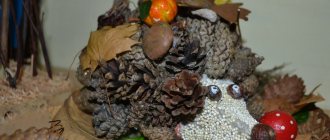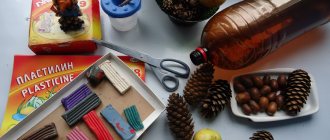Applique is one of the favorite activities for children of different ages; you can make almost any object, and you can also use various materials for it. As a rule, they are most often made from paper, but plasticine, natural materials (leaves, dried berries), cotton pads, pasta are also used as the main material...
Plasticine - the basis for applique
Plasticine is a fairly popular material for creating applications on various themes. It is worth noting that children can start making appliques from this material from about 1.3-1.5 years old, with the simplest and lightest objects.
Using molded material, you can create beautiful original applications in several techniques, both simple standard and volumetric work. One of the best and most popular materials on which it is recommended to create a craft of this kind is a sheet of plain or colored cardboard.
Plasticine applique techniques
You can create an applique from plasticine in several ways; in some cases they can be combined to obtain a more original picture. The following techniques are distinguished:
Smudging is one of the simple methods that can be used by a young child. When creating, you can use printed drawings and prepared templates or use your drawing skills.
The basic principle of operation is to smear the plasticine with your fingers over the prepared drawing, and choose different colors accordingly. In order for the work to turn out as beautiful and neat as possible, you should very carefully and carefully smear the plasticine, with a thin ball, not to go beyond the contours.
Plasticine flagella are an excellent basis for creating original appliques on various themes. To work with this technique, you need to soften the plasticine well, roll it into a thin rope, and then roll it into the required shape, usually a circle or oval. You can also lay out some elements of the composition in the form of a flagellum.
Mosaic is one of the most popular techniques for creating plasticine appliqué. Both an older and a small child can work in this technique. The main principle of this technique is to fill the picture with small plasticine balls.
For such an application made of plasticine on cardboard, templates are best suited, because after printing the finished drawing, it will be easier to navigate all the elements and select the color scheme.
Volumetric applique is a great option for older children. All elements of the work are created in volume and carefully attached to a sheet of cardboard.
Quilling or flagella
A realistic picture with a certain plot will be obtained if you use flagella rather than a thin layer of plasticine to fill the picture. They are prepared in advance; for this, plasticine of different colors is rolled into balls, which are gradually stretched into thin stripes.
Filling any space with flagella is very simple; for this, direct and reverse laying techniques are used. For figures with smooth lines (berries and fruits, animal figures), it is better to use the circular laying technique, the end of the flagellum is placed in the center and twisted in a spiral.
Recommendations
To make it simpler and easier to create a beautiful and original application from plasticine, you should pay attention to the recommendations of experts:
- It is best to use wax-based plasticine; it is softer and easier to work with.
- For gluing, you can use not only paper and cardboard, but also a photo frame, plate, tray, it all depends on the subject of the work.
- If the application is created using tourniquets, then it is recommended to make them using a syringe without a needle so that they are of the same diameter. Before placing the material into the syringe, it should be softened a little.
- It is best to start getting acquainted with this type of creativity with simpler and lighter paintings.
Girl in a boat
When the swimming device is ready, we move on to making the girl. Using strokes we create her face and hand, and then we lay out her hair and dress with plaits. And again you need to remember about light and shadow. The hair on the right will be darker and the hair on the left will be lighter. The dress should be made in layers, and you should start making it from the end, that is, from the hem. We apply strands tier by tier, creating the effect of voluminous ruffles. Let's move on to the final part - “drawing” the sea. The waves will look like swirling snails. They also need to be made in layers to create the effect of background and foreground. Some circles can be emphasized with white stripes - these will be highlights. We make a frame from the strands, and on top you can depict a wave to show the infinity of the water element.
Simple applications from plasticine
Good options for small children:
- sun and clouds;
- flower;
- tree;
- mushroom;
- chick;
- butterfly;
- fruits and berries.
It is recommended to use the smudging or mosaic technique.
To create applications from plasticine on cardboard for children 4 years old and older, you can use other techniques, and use the same blanks.
Floral appliques made of plasticine
The flower theme is a favorite theme for children of all ages. You can make a flower applique from plasticine on cardboard using any technique and even combine several into one work. You can also make a floral applique in the form of a postcard or panel.
Vase with Flowers
Using the mosaic technique, you can create a beautiful and unusual applique in the form of a vase with flowers. For such work, you only need to prepare a sheet of cardboard of the desired color or a standard one - white, a set of plasticine, a pencil.
Step-by-step execution plan:
- Draw a vase and 3-5 flowers on a sheet of cardboard.
- Soften the plasticine.
- Take the prepared plasticine for flowers and roll small balls out of it, attach them to the drawn flower, slightly pressing it onto the cardboard.
- Also roll balls from green plasticine and attach them as leaves and stems.
- Prepare the balls for the vase and repeat the action.
If desired, you can make a vase not of one color, but with decorative elements.
Application from plasticine - aquarium
An aquarium is an excellent option for appliqué made from plasticine on cardboard for grade 2 and older, depending on the technique and number of elements.
An interesting option for creating an application on this topic using several techniques, namely the use of mosaics, flagella and smearing.
Creation plan:
- Draw a blank on the cardboard: seaweed, fish, water bubbles, decorative pebbles and shells.
- Place algae and bubbles using flagella.
- Lay out fish, shells and pebbles using small plasticine balls using the mosaic technique.
- Make the space of the aquarium out of soft blue plasticine using the smearing technique.
In order to get a beautiful color to fill the aquarium, you can combine white and blue plasticine and knead it well.
Progress of the master class
We can talk a lot about the importance of modeling classes not only in kindergarten, but also in family education.
And before we begin our master class, let me remind you that modeling classes have a complex effect on the development of a child, namely: • increase sensory sensitivity;
• develop imagination, spatial thinking, general manual skills
dexterity, fine motor skills;
• synchronize the work of both hands;
• form the ability to plan work to implement a plan.
From plasticine you can create not only three-dimensional figures of all kinds of objects: animals, birds, fish, objects or toys, but also paintings of varying complexity. In other words, you can draw with plasticine, just like with felt-tip pens or pencils.
There are many ways to paint with plasticine, one of which I want to introduce you to is plasticine painting from a syringe (creating images from flagella)
.
To create a picture we need:
-set of plasticine (soft,
- stack,
-thick cardboard for the base of the picture (you can use disposable plates, vinyl records, etc.)
- hand wipes,
- a board for plasticine,
- disposable syringe (cut off the narrow tip to make it easier to work with plasticine,
- a container with hot water.
Application from plasticine - vegetables
Vegetables are a great subject for creating fall-themed crafts. You can create an applique from plasticine in the form of vegetables using any technique, it all depends on your personal desire and skill. It is worth noting that vegetables look most colorful, bright and interesting using the mosaic technique, flagella, or in the form of volumetric work.
Young children are recommended to use the mosaic technique for this work. To obtain beautiful vegetables using flagella, you should use an ordinary syringe without a needle. With its help, all elements will be of the same diameter, will look as proportional and neat as possible in the resulting work.
Panda figurine
More difficult work. But most children cope with it successfully. The first sculpture may not be completely straight, but each time the craft becomes more and more accurate in execution. The ball rolls and needs to be slightly flattened.
The eyes are made with a knife. You get two indentations that are worked out with a black marker. Then pieces of plasticine are placed into additionally made recesses. The craft will look more interesting with beads.
The nose and cheeks are made from a small ball. They need to be flattened and attached on top. For the body we use another ball. The plasticine rolled into a rope goes onto the paws. The parts are connected together.
New Year's applique made of plasticine
New Year's theme is the most popular and favorite among children of all ages. You can make an application from plasticine on such a theme using any technique, but if you are creating a composition, it is recommended to use several methods. The most popular ideas for New Year-themed plasticine applications:
- Christmas tree with New Year's toys;
- Santa Claus, Snow Maiden, snowman, deer;
- winter landscape with snowflakes;
- composition of sledding or snowball fights.
You can also create it in the form of a greeting card with the whole composition and wishes.
Applications made of plasticine on cardboard are one of the popular and interesting options for creating crafts, which has several techniques and can be combined with each other. This type of creativity is suitable even for the smallest creative hands and promotes development, teaches accuracy and perseverance.
A little about plasticine painting
This type of art appeared relatively recently, at the end of the last century. Before this, artists sculpted three-dimensional figures from plasticine. This material was often used, and is still used today, by sculptors to quickly make any shape.
Initially, only children mastered the technique of plasticine painting. The artists considered it self-indulgence. But kindergarten teachers enjoyed smearing plasticine on cardboard with their children. This process develops fine motor skills, imagination and helps strengthen the muscles of the hands. But over time, plasticine painting went beyond the kindergarten, and today it has many fans among adults. True, professional artists still consider this type of art too primitive. But in fact, it is not primitive, but decorative. And it definitely has a right to exist.











